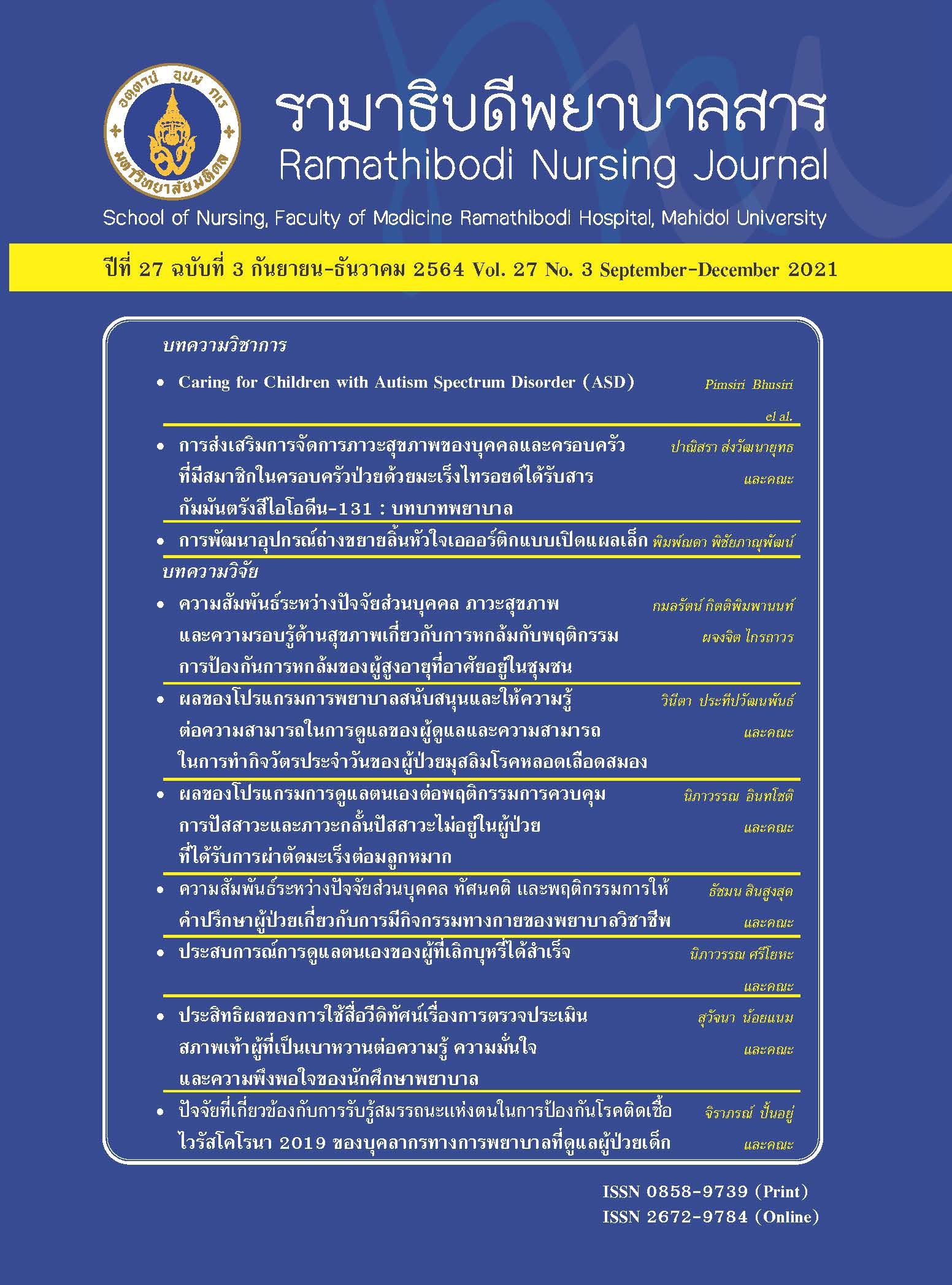The Effectiveness of Video Media about Diabetic Foot Assessment on Knowledge, Self-confidence, and Satisfaction of Nursing Students
Main Article Content
Abstract
This one-group quasi-experimental study with the pretest-posttest design aimed to compare knowledge and self-confidence before and after using the video media about diabetic foot assessment and evaluate satisfaction after using the video media.The sample consisted of 106 fourth-year nursing students. The research instruments included the video media about diabetic foot assessment and the questionnaires for data collection consisting of 1) the demographic data form, 2) the knowledge questionnaire,3) the self-confidence questionnaire, and 4) the satisfaction with the video media about diabetic foot assessment. Data were analyzed using descriptive statistics and paired t-test. The results revealed that nursing students had significantly higher scores on knowledge and self-confidence in diabetic foot assessment after using the video media about diabetic foot assessment than the pretest scores. The nursing students were very
satisfied with the video media. The results showed that using video media in the teachinglearning
process should be applied to enhance the knowledge and self-confidence of nursing students before the actual nursing practice. Therefore, to strengthen nursing students’ knowledge and self-confidence before practicing in an actual situation, video media can be a suitable method to complement the teaching-learning process by enabling the learners to practice repeatedly until being confident.
Keywords: Video media, Diabetic foot assessment, Knowledge, Self-confidence,Nursing students
Article Details
บทความ ข้อมูล เนื้อหา รูปภาพ ฯลฯ ที่ได้รับการตีพิมพ์ในรามาธิบดีพยาบาลสาร ถือเป็นลิขสิทธิ์ของวารสาร หากบุคคลหรือหน่วยงานใดต้องการนำทั้งหมดหรือส่วนหนึ่งส่วนใดไปเผยแพร่หรือเพื่อกระทำการใด ใด จะต้องได้รับอนุญาตเป็นลายลักษณ์อักษรจากรามาธิบดีพยาบาลสารก่อนเท่านั้น
References
Forbes H, Oprescu FI, Downer T, Phillips NM,McTier L, Lord B, et al. Use of videos to support
teaching and learning of clinical skills in nursing education: a review. Nurse Educ Today. 2016;42:53–56.
Nadeem M, Nasir S, Moazzam KA, Kashif R. The impact of information and communication technology
in education: opportunities and challenges. Int. J.Educ. Res. 2018;12(12):1591–6.
Gerdruang A. Empowering learning in the 21st century for Thailand society in the digital age. Lampangrajabhat University Journal. 2017; 6(1):173-84. (in Thai)
Anderson DR, Kirkorian HL. Media and cognitive development. In: Lerner RM, editors. Handbook of
child psychology and developmental science.Hoboken, New Jersey: John Wiley & Sons; 2015.pp.1–46.
Fayaz A, Mazahery A, Hosseinzadeh M, Yazdanpanah S. Video-based learning versus traditional method for
preclinical course of complete denture fabrication. JDent (Shiraz). 2015;16(1 Suppl):21–28.
Bachelor of Nursing Science Program, Faculty of Medicine Ramathibodi Hospital Mahidol University;
[cited 2020 December 25]. Available from Faculty of Medicine Ramathibodi Hospital Mahidol
University Web site: https://med.mahidol.ac.th/th/education/program_nurseth
World Health Organization. Diabetes; 2020 [cited 2020 July 8]. Available from World Health Organization Web site: https://www.who.int/health-topics/diabetes#tab=tab_1
Zhang P, Lu J, Jing Y, Tang S, Zhu D, Bi Y. Global epidemiology of diabetic foot ulceration: a systematic
review and meta-analysis. Ann Med. 2017;49(2):106–16.
International Diabetes Federation. Diabetes complications; 2020 [cited 2020 December 25].Available from International Diabetes Federation Website: https://www.idf.org/aboutdiabetes/complications.html
Kongprasert J, Vatcharasin S, Apinya T. The screening and management of foot complication in diabetes
guidelines. 1sted. Agricultural Co-operative Federation of Thailand, Bureau of Non Communicble Disease, Department of Disease Control, The Ministry of Public Health; 2015. (in Thai)
Apelqvist J. Diagnostics and treatment of the diabetic foot. Endocrine. 2012;41(3):384–97.
Sarinnapakorn V, Sunthorntepwarakul T,Deerochanawong C, Niramitmahapanya S,Napartivaumnuay N. Prevalence of diabetic foot ulcers and risk classifications in type 2 diabetes mellitus patients at rajavithi hospital. J Med Assoc Thai. 2016;99(2): S99-105.
Jungpanich A, Srisailaun O. Effects of using daily care plan video teaching on clinical self-confidence
and satisfaction of nursing students, Kuakarun Faculty of Nursing, Navamindradhiraj University. Kuakarun
Journal of Nursing. 2015;22(1):17-34. (in Thai)
Chutabhakdikul N. Digital generation. Encylopedia of Education. 2015; 50:79-83. (in Thai)
Klaypetch P, Kanchai S, Plengkratoke S. Satisfaction and learning outcome of nursing students about
learning media for promote to basic nursing skills.Proceeding the 2nd NEU national and international
research conference 2014.2014:1-10. (in Thai)
Saenboonsong S, Emrat N, Jantrasi S. The development of multimedia for learning on search engine of seventh grade students at watphrakhao school, Phranakhon SiAyutthaya. Walailak Journal of Learning Innovations.2018;4(2):1-15. (in Thai)
Murthykumar K, Veeraiyan DN, Prasad P. Impact of video based learning on the perfomance of post
graduate students in biostatistics: a retrospective study.J Clin Diagn Res. 2015;9(12): 51–3.
Tayade A, Tayade S, Chalak A, Srivastava T. The impact of video assisted learning (VAL) on slow
learners. Int J of Biomed &Adv Res. 2018;30;9(1):13–8.
Bloom BS. Human characteristics and school learning.New York: McGraw-Hill; 1976.
Mayer RE. The cambridge handbook of multimedia learning. 2nd ed. Cambridge: Cambridge University
Press; 2009.
Cohen JW. Statistical power analysis for behavioral sciences. NJ: Lawrence Erlbaum Associatiates; 1988.
Suresh K, Chandrashekara S. Sample size estimation and power analysis for clinical research studies. J Hum
Reprod Sci. 2012;5(1):7–13.
Chuang YH, Lai FC, Chang CC, Wan HT. Effects of a skill demonstration video delivered by smartphone
on facilitating nursing students’ skill competencies and self-confidence: a randomized controlled trial study. Nurse Educ Today. 2018; 66:63–8.
Rajesh S. Effectiveness of video assisted teaching programme on knowledge regarding non
pharmacological pain relieving intervention for children among staff nurses in selected hospital. Asian
J Multidiscip Stud. 2014;2(10),122-33.
El Sayad R, El Raouf S. Video-based lectures: an emerging paradigm for teaching human anatomy and
physiology to student nurses. Alexandria J Med.2013;49(3):215–22.
Mayer RE. Research-based principles for designing multimedia instruction. In: Benassi VA, Overson CE,
Hakala CM, editors. Applying science of learning in education: infusing psychological science into the
curriculum.2014; 59-70.
Hansen M, Oosthuizen G, Windsor J, Doherty I, Greig S, McHardy K, et al. Enhancement of medical interns’
levels of clinical skills competence and self-confidence levels via video iPods: pilot randomized controlled
trial. J Med Internet Res. 2011;13(1):1-10.
Sanongdej W, Wangpitipanit S, Chonsin P,Chalermpichai T. Development and effect of video
media combined with scenario on knowledge and self-confidence in practice of occupational health
nursing for nursing students. Ramathibodi Nursing Journal. 2018;24(1):94-107. (in Thai)
Pakdeto R, Sawasdipanich N, Suntiti R. Effect of a computer–assisted instruction of nursing care of
children with intravenous fluid therapy toward knowledge and clinical decision-making of nursing
students. Journal of Boromarajonani College of Nursing,Bangkok. 2013;29(1):110-20. (in Thai)


